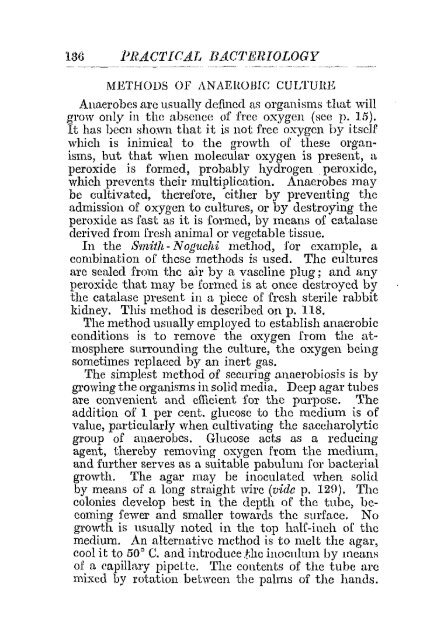AGf~ICULTURAL RESEARCH, PUSA.
AGf~ICULTURAL RESEARCH, PUSA.
AGf~ICULTURAL RESEARCH, PUSA.
You also want an ePaper? Increase the reach of your titles
YUMPU automatically turns print PDFs into web optimized ePapers that Google loves.
METHODS OF ANAEROBIC CULTURE<br />
Anaerobes are usually defmed as organisms that will<br />
grow only in the absence of free oxygen (see p. 15).<br />
It has been shown that it is not free oxygcn by itself<br />
which is inimical to the growth of these organisms,<br />
but that when molecular oxygen is present, a<br />
peroxide is formed, probably hydrogen peroxide,<br />
which prevents their multiplication. Anaerobes may<br />
be cultivated, therefore, either by preventing the<br />
admission of oxygen to cultures, or by destroying the<br />
peroxide as fast as it is formed, by means of catalase<br />
derived from fresh animal or vegetable tissue.<br />
In the Smith - N ogueld method, for example, a<br />
combination of these methods is used. Thc cultures<br />
are sealed from the air by a vaseline plug; and any<br />
peroxide that may be formed is at once destroyed by<br />
the catalase present in a piece of fresh sterile rabbit<br />
kidney. This method is described on p. lIS.<br />
The method usually employed to establish anaerobic<br />
.conditions is to remove the oxygen from the atmosphere<br />
surrounding the culture, the oxygen being<br />
sometimes replaced by an inert gas.<br />
'fhe simplest method of securing anaerobiosis is by<br />
growing the organisms in solid media. Deep agar tubes<br />
are convenient and effwient for the pUl'pose. The<br />
addition of 1 per cent. glucose to the medium is of<br />
value, particularly when cultivating the saccharolytic<br />
group of anaerobes. Glucose acts as a reducing<br />
agent, thereby removing oxygen from the medium,<br />
and fUl'ther serves as a suitable pabulum fOl' bacterial<br />
growth. The agar may be inoculated when solid<br />
by means of a long stmight wirc (vide p. 120). Thc<br />
colonies develop best in the depth of the tube, becoming<br />
fewer and smaller towards the surface. No<br />
growth is usually noted in thc top half-inch of the<br />
medium. An alternativc method is to melt the agar,<br />
cool it to 50 0<br />
C. and introduce nlC inOCllllll11 by means<br />
of a capillary pipette. The contents of the tube are<br />
mixed by rotation between thc palms of the hands.

















